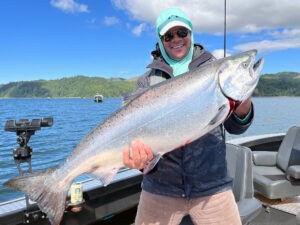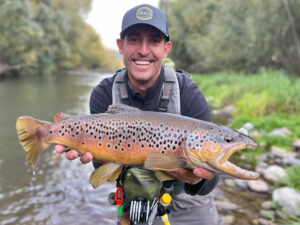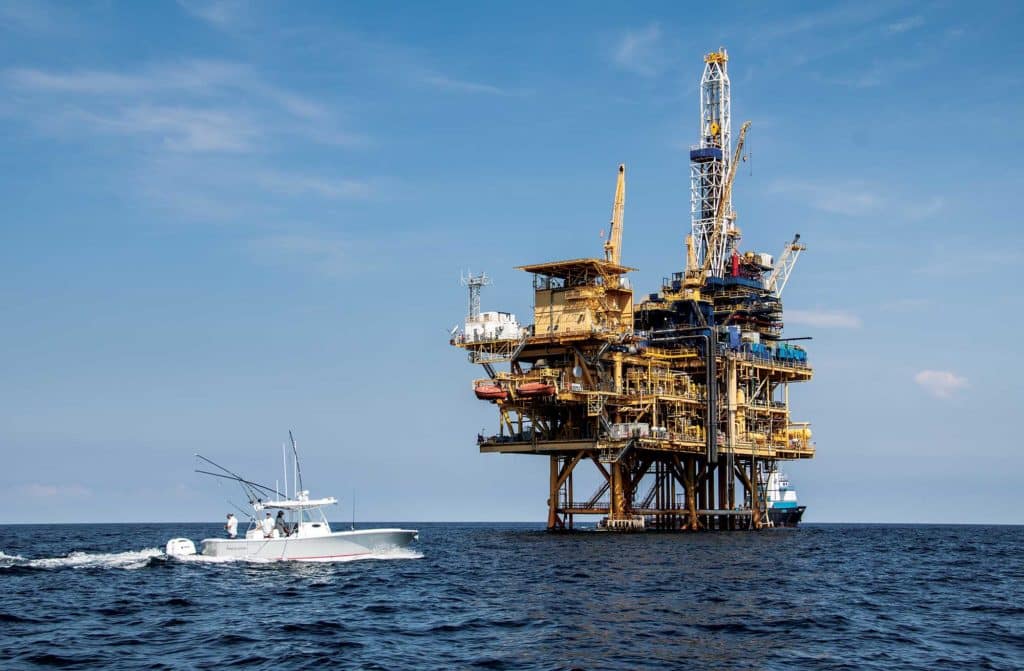
The VHF crackled to life: “We have a fish hooked up, and it’s big!”
On the mic was Forrest Long, owner of Bluewater Yachts, the Regulator Marine dealer in Orange Beach, Alabama. I sensed the excitement in his voice. Long was aboard a Regulator 31, owned and skippered by his brother, Bennett. On the rod was local angler Angelo DePaola.
I was aboard a nearby second boat, and upon hearing the news, we decided to go take pictures and video of the fish. By the time we arrived, the battle had neared its end. From our vantage point, I could make out the colors of a 100-plus-pound yellowfin tuna in the purple-blue waters below. The sweat poured off DePaola as he battled the powerful tuna on this windless, 90-degree day.
The fish circled about 10 or more times, and then succumbed to line pressure. Forrest sank the gaff, and with the help of Bennett and crewmember Daniel Robinson, hauled the yellowfin on deck through the starboard-side boarding door. The smack of high-fives resounded across the water.
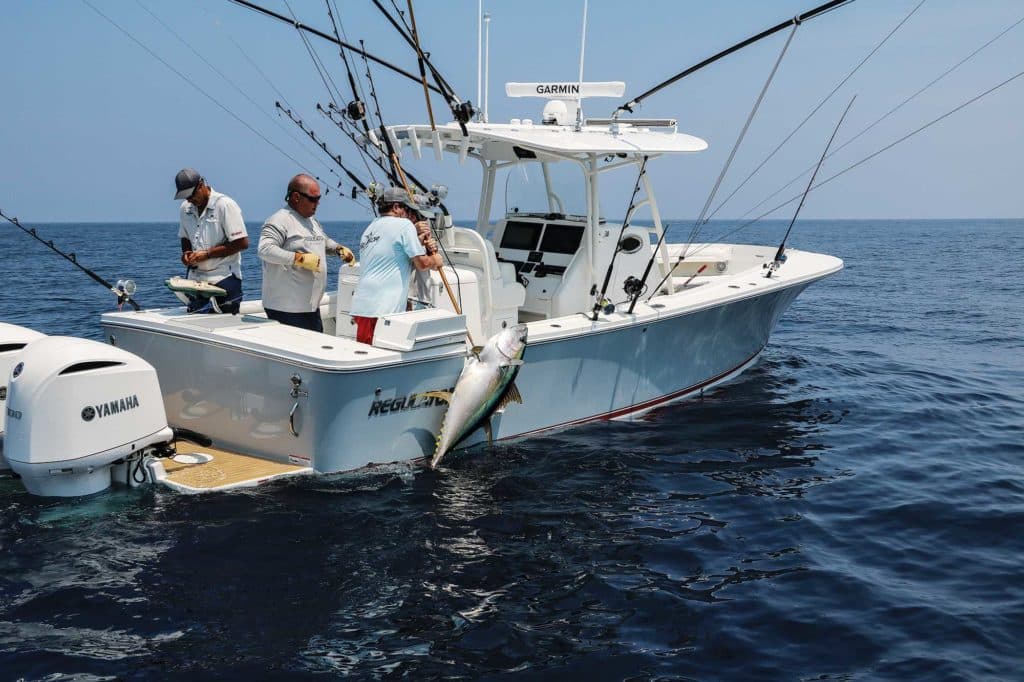
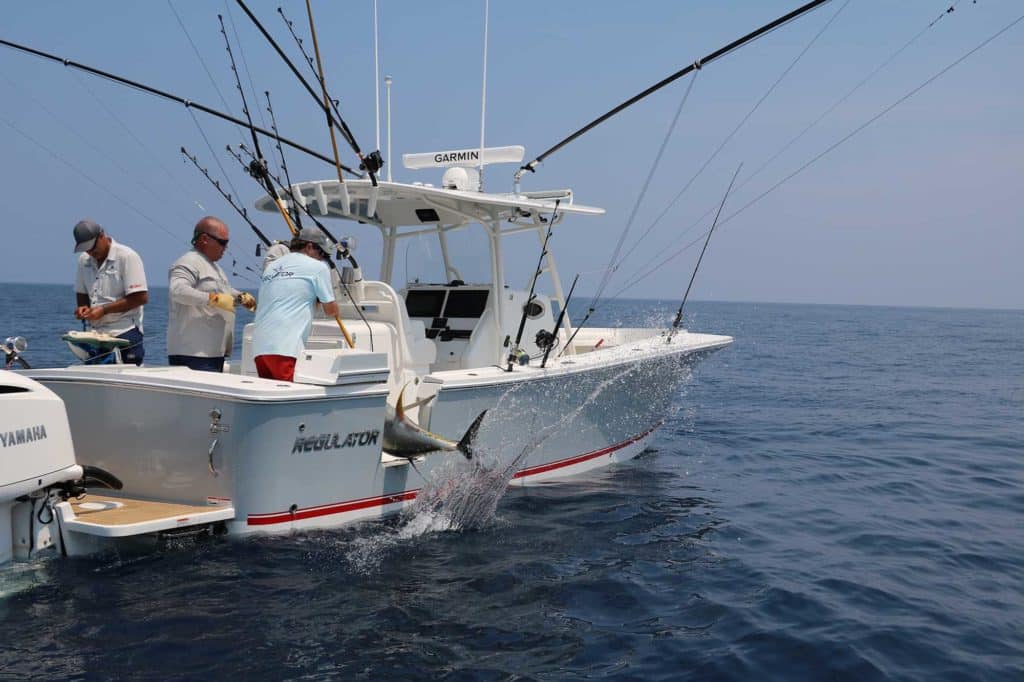
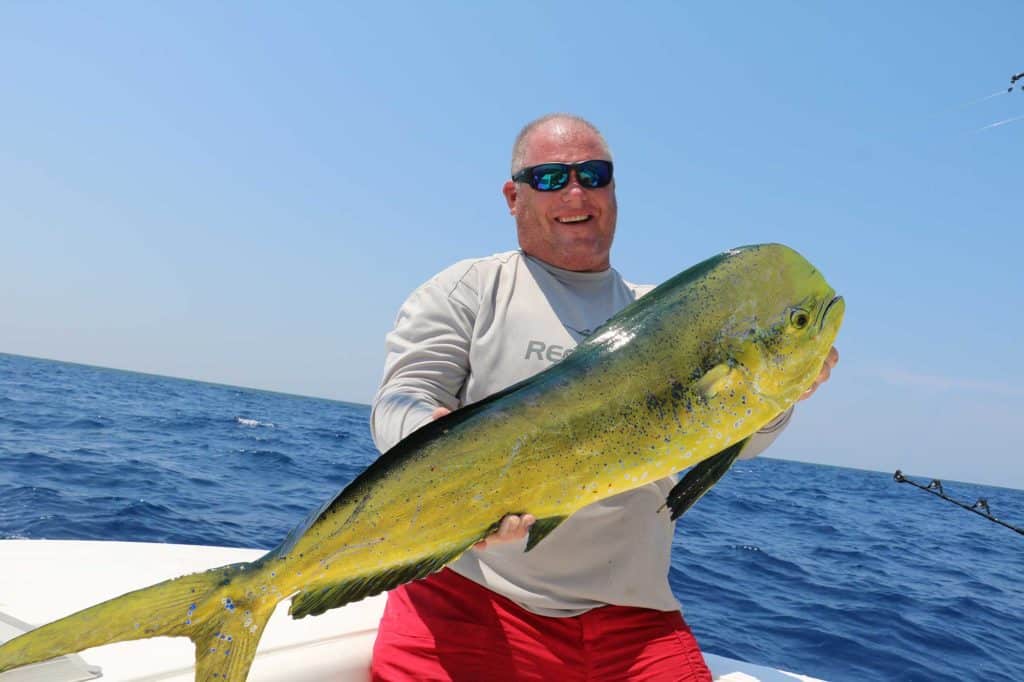
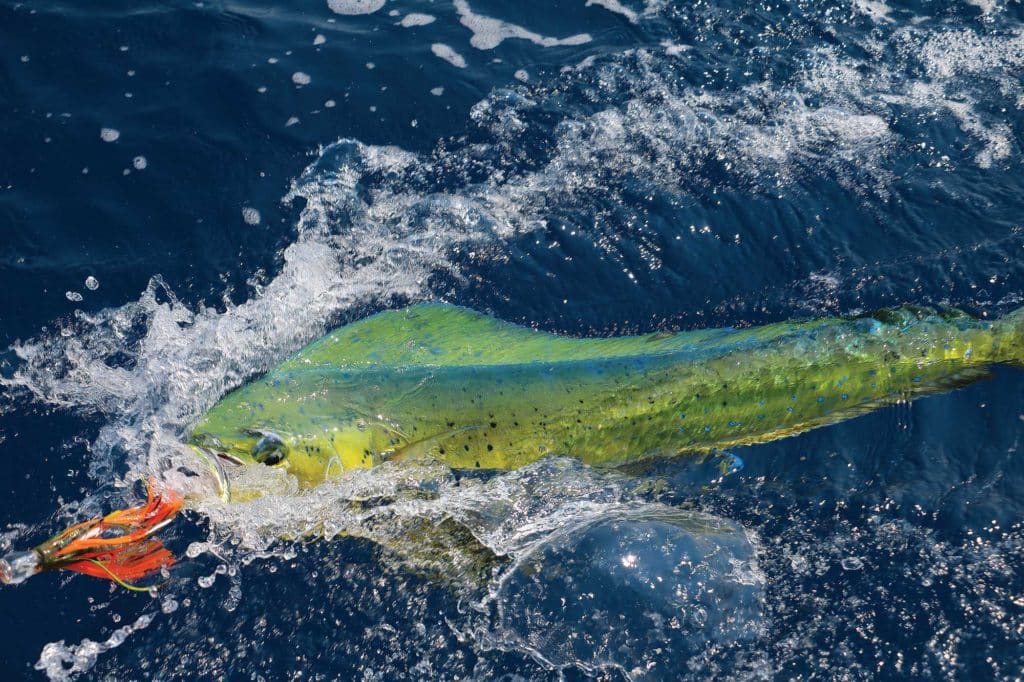
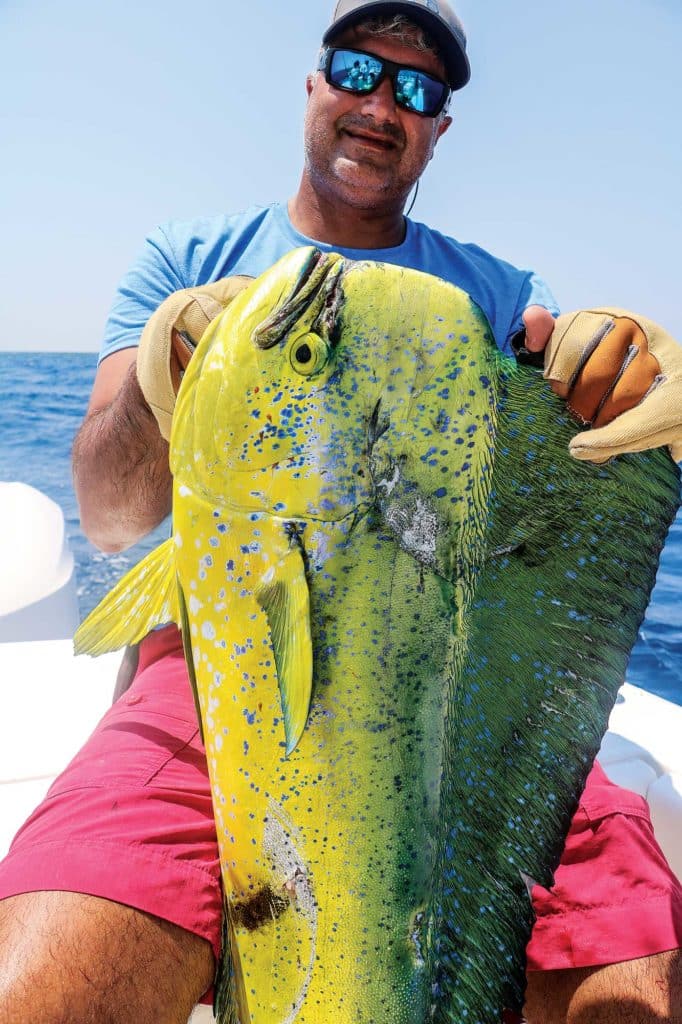
Long Run
This is the kind of world-class offshore fishing that anglers frequently experience in the upper Gulf of Mexico. While yellowfin tuna are often the primary target, they are certainly not the only glory fish in these waters. During our late May trip, we caught blue marlin, mahi and wahoo, as well as tuna, while trolling. Deep‑dropping can pay off with large grouper, tilefish and swordfish.
When wind and waves calm, access to this fishery proves fairly easy — as little as 30 miles away for boating anglers departing from the mouth of Louisiana’s Mississippi River Delta, which juts far into the Gulf.
Yet for anglers departing from Alabama or Mississippi, it’s a different story. Those state coastlines recess to the north, and the run to find blue water can range up to 150 miles. That demands a boat with generous fuel capacity, strong seakeeping abilities, and the speed to reach the grounds and get back at a decent pace.
Faced with those issues, some Alabama and Mississippi boating anglers choose to stay overnight so they can get in another day or two of fishing before heading back to port.
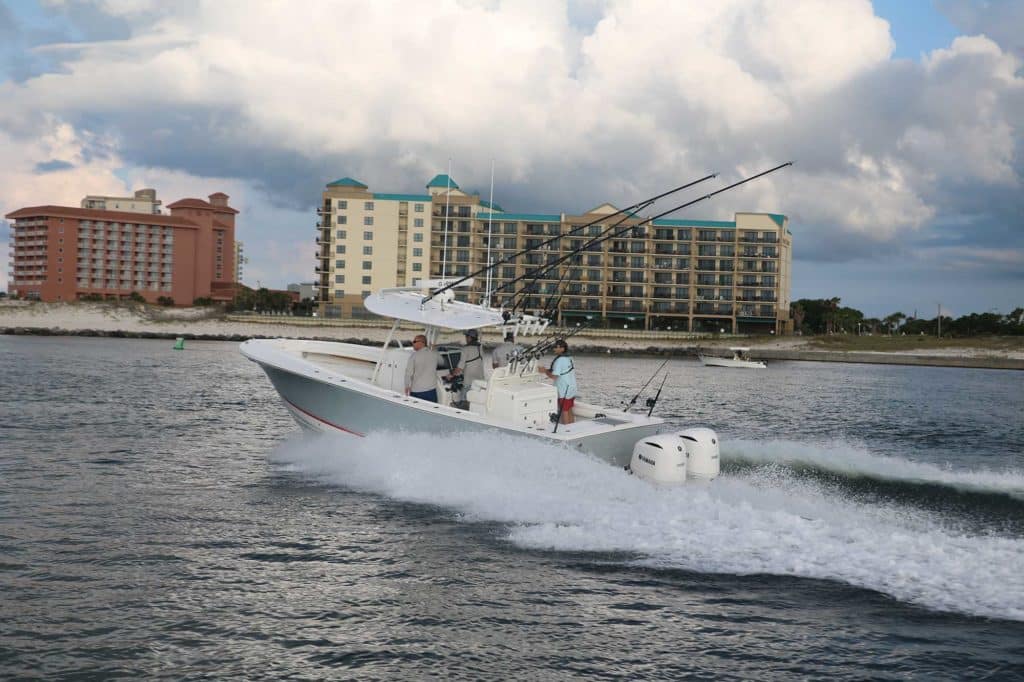
Shore Thing
If you choose to stay overnight, one option is to sleep aboard. This might seem like a viable option aboard a yacht, but on center-consoles without cabins or berths, it can be downright uncomfortable. Plus, someone needs to stand watch at all times.
However, there’s an alternative to rocking and rolling while struggling to sleep aboard the open deck of a center-console. This option not only offers hot meals and a comfy bed, but also the chance to refuel and ice up for the next day.
Many boats retreat to marinas near Venice, Louisiana, along the fingers of the Mississippi Delta, that offer gas, ice, meals, provisions and lodging. However, the closest lodge to the offshore fishing grounds lies about 20 miles south of Venice. High Adventure at Port Eads (pronounced like “deeds”) is nestled just a couple of miles inside South Pass.
It’s a great place to tuck in for the evening, resupply and get some rest before heading back offshore. That’s exactly what we did on our two-day, one-night offshore adventure.
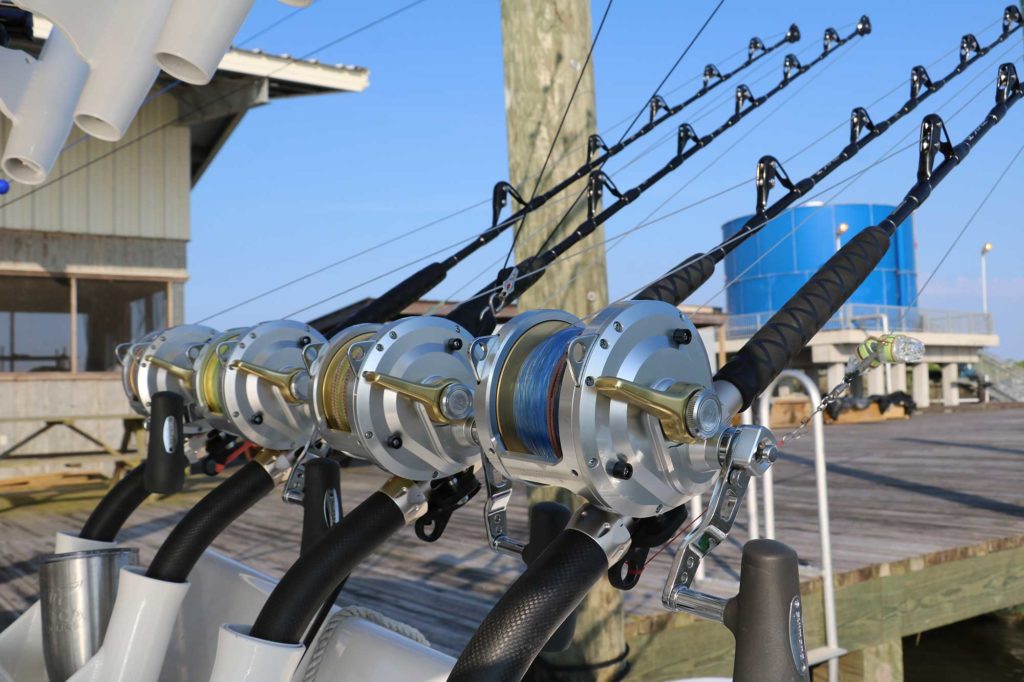
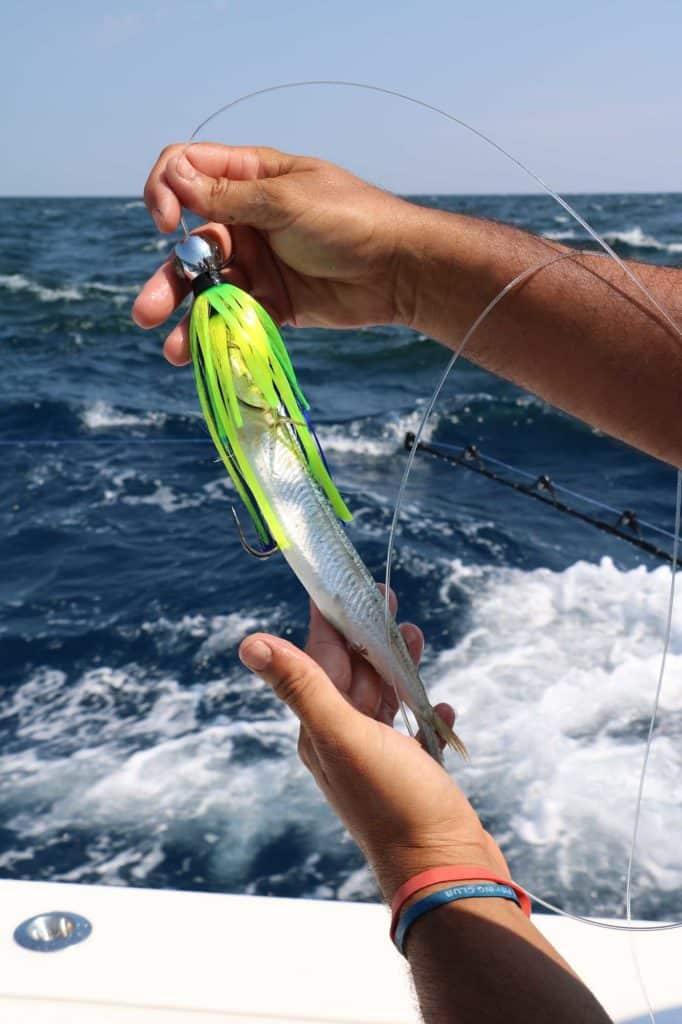
Scouting for Blue
Planning is a critical part of these trips, especially when it comes to finding the undulating, ever-changing edges of blue water in the upper Gulf. On the evening before our departure, at Fisher’s Restaurant at the Orange Beach Marina, where the crew dined and finalized details of the trip, all eyes were on Roffer’s Ocean Fishing Forecasting Service mobile app. This gave us a weather forecast, as well as a chlorophyll report, indicating how far we would need to run to find blue water.
“We need to find the rip line,” said DePaola, who has fished these waters virtually his entire life. This is where the blue waters of the Gulf current meet the nutrient-rich coastal waters, DePaola explained.
“It forms a rip line of sargassum weed and an abrupt change in water color,” he added. “Fish such as blue marlin, mahi and tuna feed along the blue side of the rip line.”
The Roffer’s chart indicated outstanding weather — light winds and flat seas — which was good, since the chart also showed that the edge of blue water lay about 120 miles off the coast of Alabama.
Early on during the planning, the crew at Bluewater Yachts had decided to take two boats to add an element of safety, and give us the opportunity to shoot photos and videos back and forth. The second boat was a legacy-model 2000 Regulator 26 Classic owned, restored and skippered by Maclin Smith, owner of HMS Marine Electronics, based in Fairhope, Alabama, and crewed by Smith’s buddy, Allen McCall. Regulator’s videographer, Bobby Layden, and I would switch back and forth between boats to cover the action.
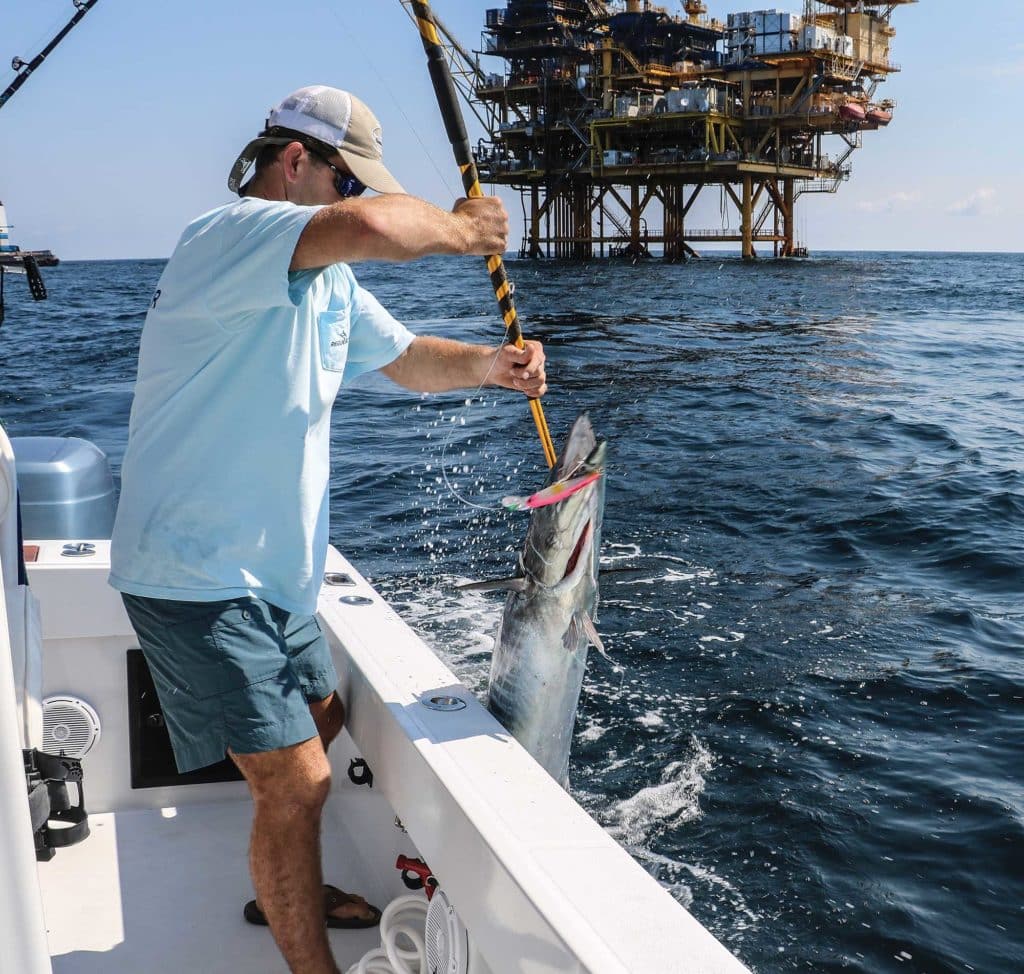
Rig Game
All hands met at Orange Beach Marina by first light the next morning, eager to depart. We all pitched in to load drinks, provisions and lots of ice. By sunrise we exited Perdido Pass, cruising at about 35 mph on a southerly heading.
While the distant rip line remained our ultimate target, the captains decided to make one stop en route at an oil platform known as Virgo, about 70 miles from Orange Beach in 1,150 feet of water.
Aboard the Regulator 26 Classic, Smith and McCall set out a pair of pink Russelure 6½-inch deep-diving plugs and began trolling around the oil rig. It was a good decision. Within minutes, a fish attacked the starboard lure, sending the clicker singing.
Line peeled off the reel as McCall grabbed the rod and battled the fish while Maclin kept the boat in gear at dead idle. McCall’s first guess was a barracuda. But the prolonged battle had him second-guessing himself, and then deep color revealed its true identity: a wahoo in excess of 50 pounds.
As the fish drew close, Maclin deftly gaffed it and swung the ’hoo aboard. Meanwhile, the crew on the 31 was also enjoying success. They had landed two wahoo while trolling the same deep‑diving plugs around Virgo.
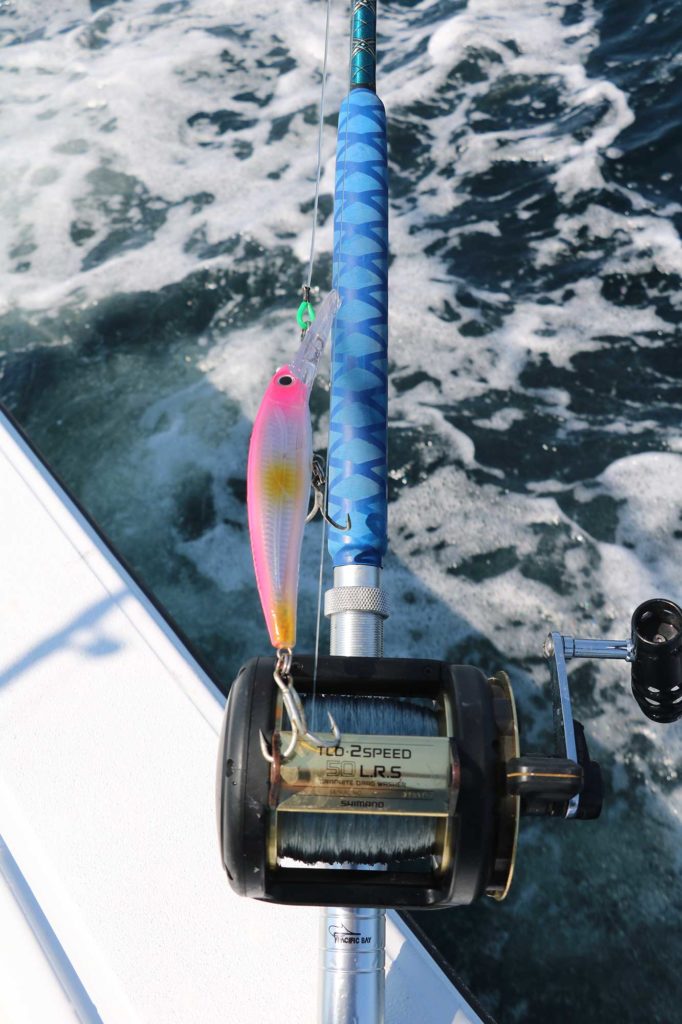
Looking for a Break
After a few more unproductive trolling passes, we continued to cruise toward the coordinates where Roffer’s had shown the rip line hours earlier. The flat seas allowed the boats to ramp up the speed to 40 mph, and in just over an hour, we reached the area. Unfortunately, all we found upon our arrival was the off-color coastal water.
Since we were well out of cell range, we couldn’t access satellite-imagery updates. It was a guessing game now as to where the rip line might lie. The captains conferred over the VHF, and decided to continue running on a southerly heading. Anxiety melted away 30 minutes and 20 miles later when we finally reached blue water.
Both boats set out trolling spreads of rigged, skirted ballyhoo with J hooks and began trolling along the blue side of the color break.
The Classic 25 trolled five lines that included two medium outrigger lines, two short flat lines and a long line down the middle. Reels were Shimano TLD 50 two-speeds loaded with 80-pound monofilament. Rods were custom all‑roller, bent-butt 6-foot trolling sticks.
The 31 set out a spread of seven lines with two medium lines on each outrigger, two short flat lines, and a long line down the middle. Reels were Shimano Talica 50 two-speeds spooled with 80-pound braided line and 130-pound-test wind-on top shots. Rods were 5-foot-9-inch Shimano Tallus all-roller, curve-butt rods with all AFTCO roller guides.
Just a few minutes into our troll, we got the excited call from Forrest Long on the VHF that they were hooked up to that first yellowfin, so we retrieved line and headed over.
After finishing up photos of DePaola’s big tuna, Maclin pulled his 26 Classic away, and McCall reset the spread as Maclin skippered the boat to parallel the color break, which was accented by floating mats of golden-brown sargassum weed.
As we trolled, Maclin explained that these waters are productive throughout the year, but the best weather occurs May through August. “With the exception of hurricanes, we have some pretty nice weather here in summer,” he pointed out. “But the weather windows tend to shrink in winter.”
Our conversation was abruptly interrupted when the line snapped free from the port outrigger and began peeling off the reel as a colorful bull mahi danced in the wake. It soon joined the wahoo on ice in the fish locker.
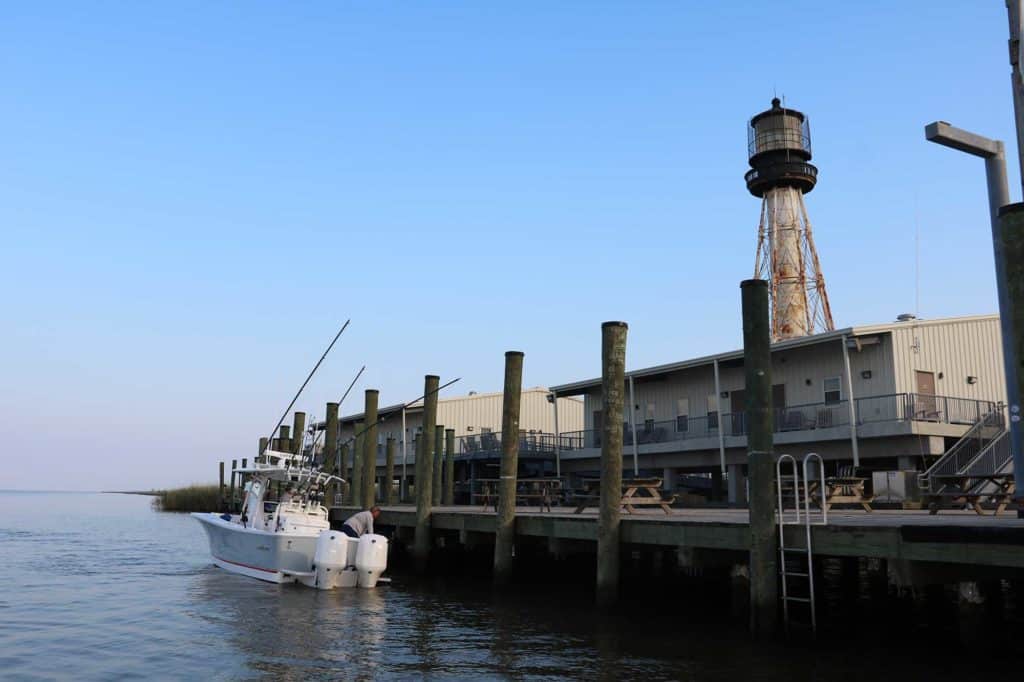
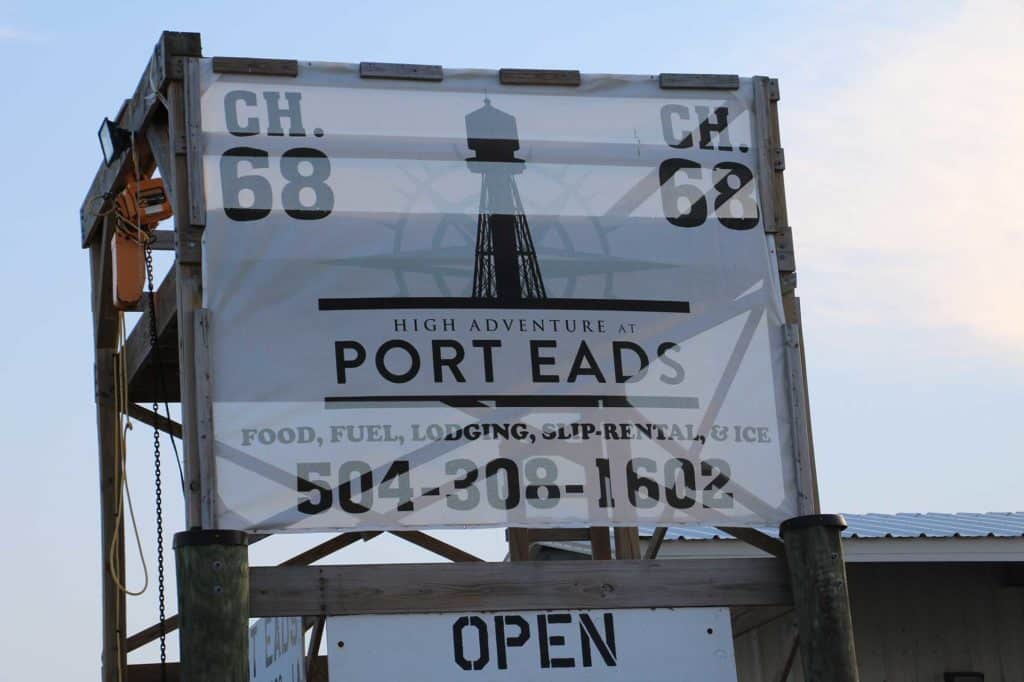
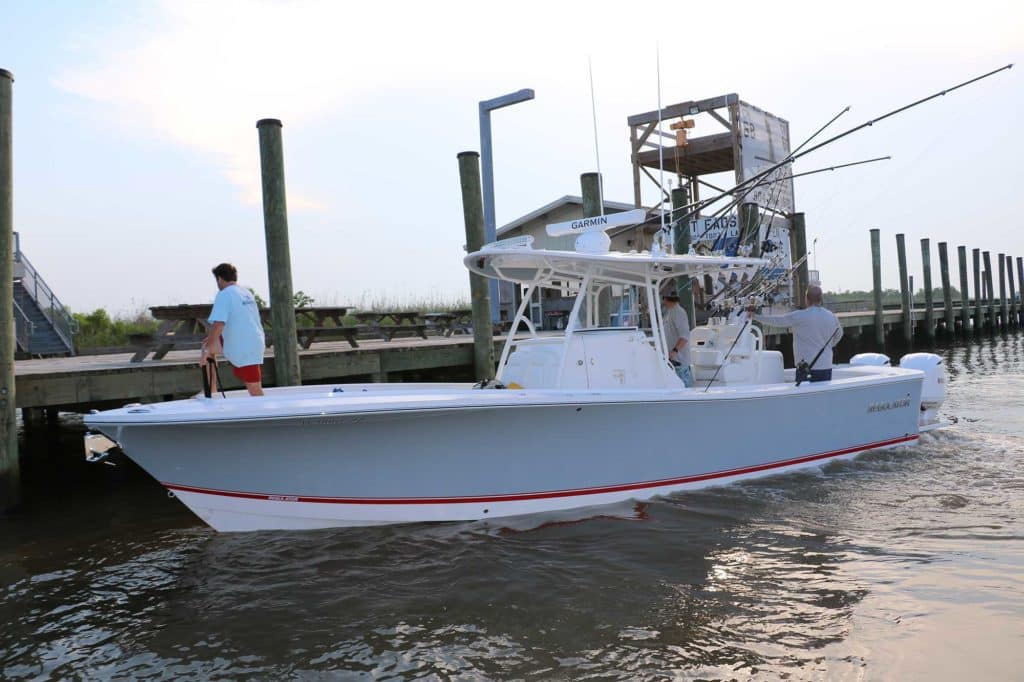
Port Eads Retreat
That pattern continued throughout the afternoon, as aggressive schools of mahi attacked the rigged ballyhoo to fill the fish locker. At around 3:30 p.m., we pulled in the lines and, along with the 31, set a northwesterly course for South Pass.
We reached the mouth of the pass in less than an hour, but both captains were careful to follow the channel markers and their tracks on the chart plotters from previous trips here as they navigated the short distance though the channel to Port Eads. The NOAA chart for this area warns of severe shoals, and some of those include rocks.
The staff at High Adventure greeted us at the docks and directed us to bunk houses. We then motored along a channel carved from the marsh that led to the marina and fuel dock behind the main lodge. We fueled up, washed the decks, and secured the boats for the evening. After a hot shower, a couple of beers, a meal of fresh mahi and rice, and a few fish stories, we were all ready for some shut-eye.
Deep-Drop Dilemma
A freshening breeze out of the northwest greeted us the next morning, complicating our plans to add some variety to our fishing itinerary. Layden and I moved to the Regulator 31 (and Forrest transferred to the 26 Classic). The crews would try some 600-foot drops on pipeline crossings in the Gulf for species such as snowy grouper.
These are relatively small spots that require precise boat positioning to fish effectively. We tried a number of drops, but a 15-knot wind and 3-foot waves prevented us from getting the baits on the structure.
Plan B was to fish the rip line again, and this time we found it quickly. It was in about the same place as the day prior. Yet the color change appeared to be even more abrupt and the weed line more concentrated, owing to the collision of wind and current.
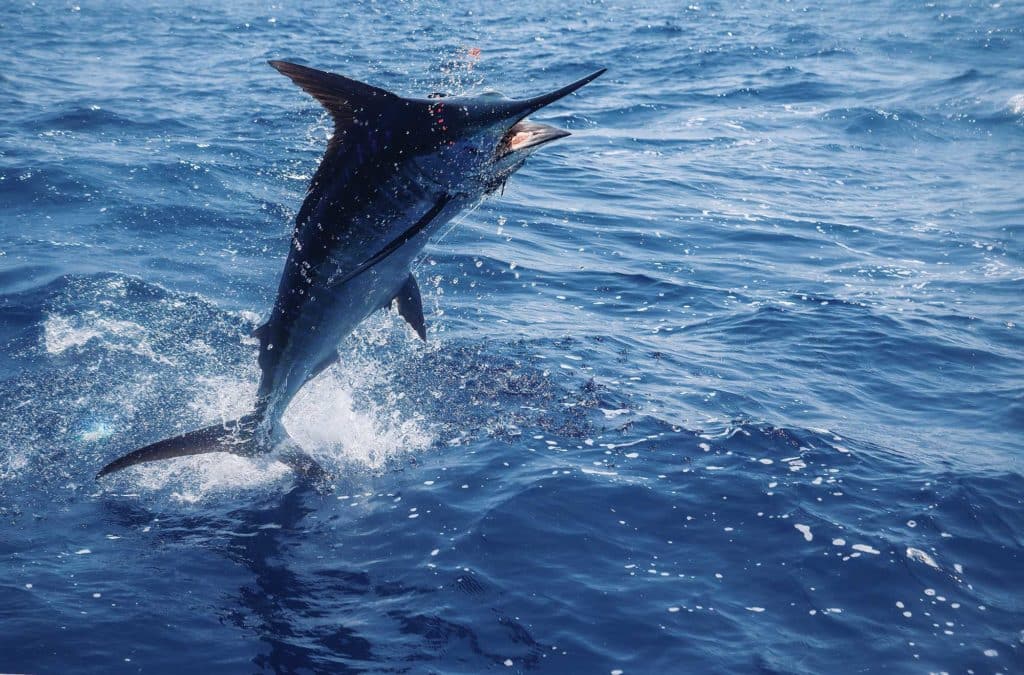
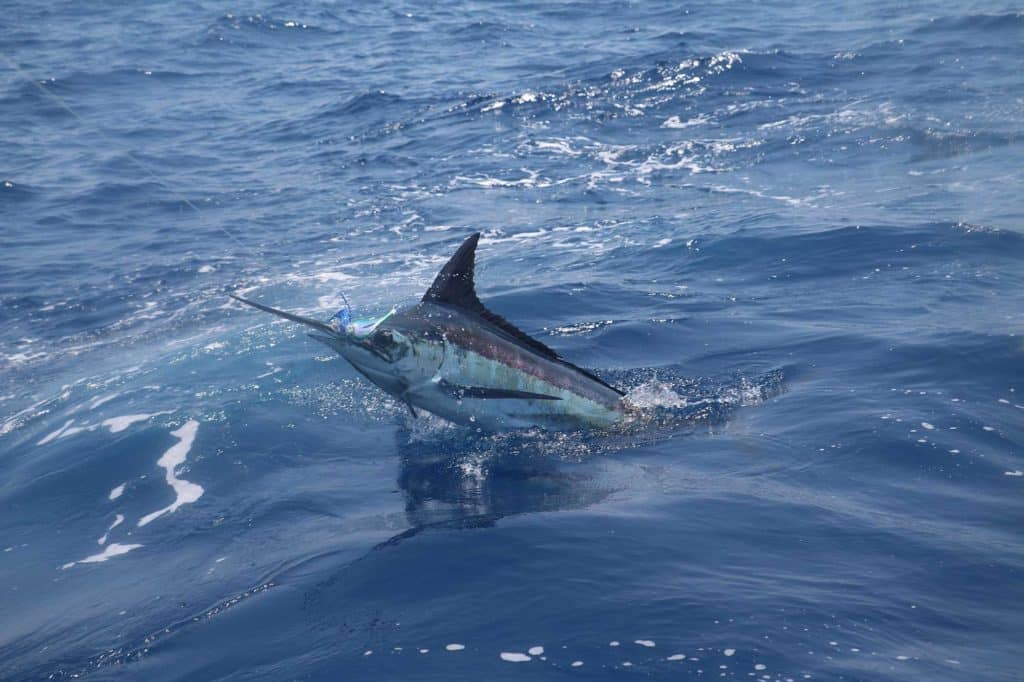
Marlin Surprise
Aboard the 31, the action picked up right where we left off, with one mahi bite after another, including a couple of fish in the 30-pound range.
Things changed dramatically in the afternoon when a blue marlin inhaled the bait on the starboard flat line. Robinson was up this time, and though he had crewed on many boats that have caught blue marlin, this was the first time he had actually fought one. He handled it masterfully, and within 20 minutes, the billfish, estimated at 125 pounds, was leadered and boat-side, ready for release.
Read Next: Upper Gulf Fishing Adventure — a New Approach
Seas began to build in the afternoon. By 3 p.m., with Orange Beach 117 miles away, we decided to turn for home. The Classic 26 had already departed. Aboard the 31, we retrieved the lines, stowed tackle and gear, and then Bennett put the boat on a northerly heading and bumped the speed up to 35 mph, with the seas on our port beam. Three-and-a-half hours later, as the sun was hanging low, we were home.
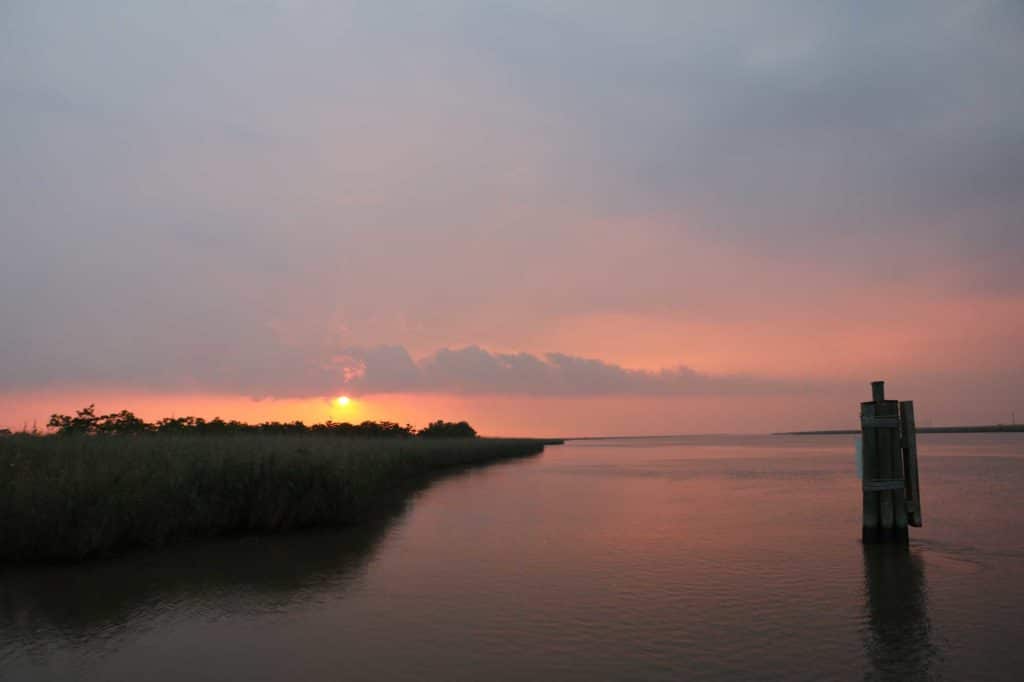
In the end, I learned that Alabama boating anglers can stage successful multiday trips to the rich Gulf waters off Louisiana. The keys to success include the right boat, decent weather, proper planning and advance reservations at a place like High Adventure at Port Eads to refuel, re-ice and refresh overnight.
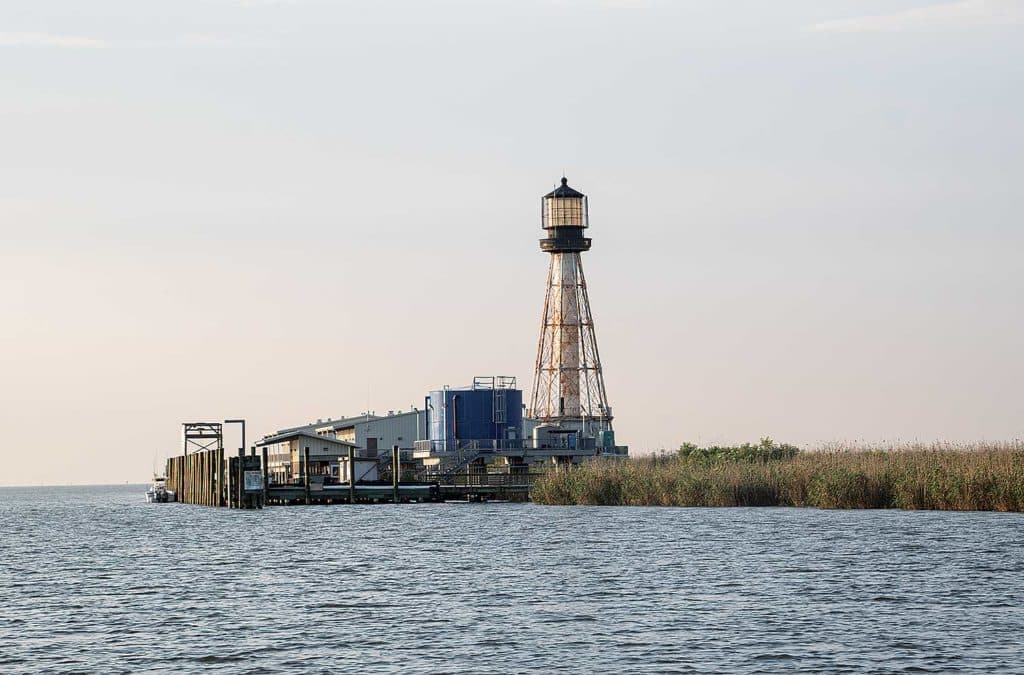
Port Eads Accommodations
Between the two days of offshore fishing, we overnighted at Louisiana’s High Adventure at Port Eads lodge just inside South Pass at the Mississippi River mouth. Here we found meals and overnight accommodations, as well as fuel and ice. The lodge is marked by the historic Port Eads lighthouse.
Completely renovated just a few years ago, this outpost is accessible only by water or air. Each room at Port Eads contains three sets of bunk beds, two of which have queen-size lower bunks, as well as a common restroom/shower. When booking at the bed rate ($65), you might be lodging with other bed-rate clients. The private-room rate ($625) reserves the entire room, no matter what the group size.
The lodge also features Finley’s Restaurant and a large family-style dining room. Menus and dining times are fixed. The facility also offers laundry rooms, fuel docks, ice machines, and 60 slips with shore power for boats up to 75 feet in length.
Port Eads is far more convenient for boating anglers than running 20 miles upriver to Venice. As noted in the main story, the NOAA chart for this area warns of severe shoals, and some of those include rocks, so it is critical to follow the aids to navigation when entering or exiting South Pass.
Learn more at highadventurecompany.com/port-eads.
Boat and Equipment
With eight people on this trip, we took two boats, giving each crew plenty of elbowroom. It also allowed us to shoot photos and video back and forth, and provided a safety element. All told, the boats covered more than 360 miles without a glitch or hiccup from either.
If you want to plan a similar trip, make sure you have a seaworthy craft with multiple engines and sufficient fuel capacity to cover the distance to the offshore rip lines (which can be as far as 150 miles from Orange Beach) and then in to Port Eads, where you can refuel for the second day (see charts below to get an idea of fuel requirements). If your boat does not carry adequate fuel, consider an auxiliary fuel bladder from a company such as ATL.
You will also need to carry plenty of ice to maintain cold storage for drinks, perishable food, frozen ballyhoo and the fish you catch. On this trip, each morning before departure, all fish lockers and coolers were loaded to the brim with ice. The Regulator 26 Classic carried 200 pounds of ice, and the 31 swallowed 320 pounds. Also, plan to stock plenty of food and liquids to keep your crew nourished and hydrated for the number of days you plan to fish.
Check the marine weather forecast to ensure your boat can handle the predicted wind and waves, and don’t hesitate to postpone if conditions look dicey. In fact, our trip needed to be canceled once because of poor weather. It’s a good idea to fill out a float plan and give it to a trusted family member or friend.
A chart plotter, sonar, radar and VHF radio prove essential on such a trip. Other safety gear to consider:
- Handheld VHF radio
- EPIRB and PLBs
- Inflatable emergency life raft
- Satellite phone
Regulator 31
Length: 31 ft. 4 in. (plus bracket)
Beam: 10 ft. 4 in.
Transom Deadrise: 24 deg.
Dry Weight: 10,500 lb. (w/ engines)
Fuel: 300 gal.
Power: Twin Yamaha F300 four-stroke V-6 outboards with Helm Master
Owner/Captain: Bennett Long
Fuel Burned: 433 gal. (208 gal. on day one, 225 gal. on day two)
Regulator 26 Classic
Length: 25 ft. 10 in. (plus bracket)
Beam: 8 ft. 6 in.
Transom Deadrise: 24 deg.
Dry Weight: 5,500 lb. (w/o engines)
Fuel: 230 gal. (includes optional 54-gal. auxiliary tank)
Power: Twin Yamaha OX200 two-stroke V-6 outboards
Owner/Captain: Maclin Smith
Fuel Burned: 325 gal. (175 gal. on day one, 150 gal. on day two)



